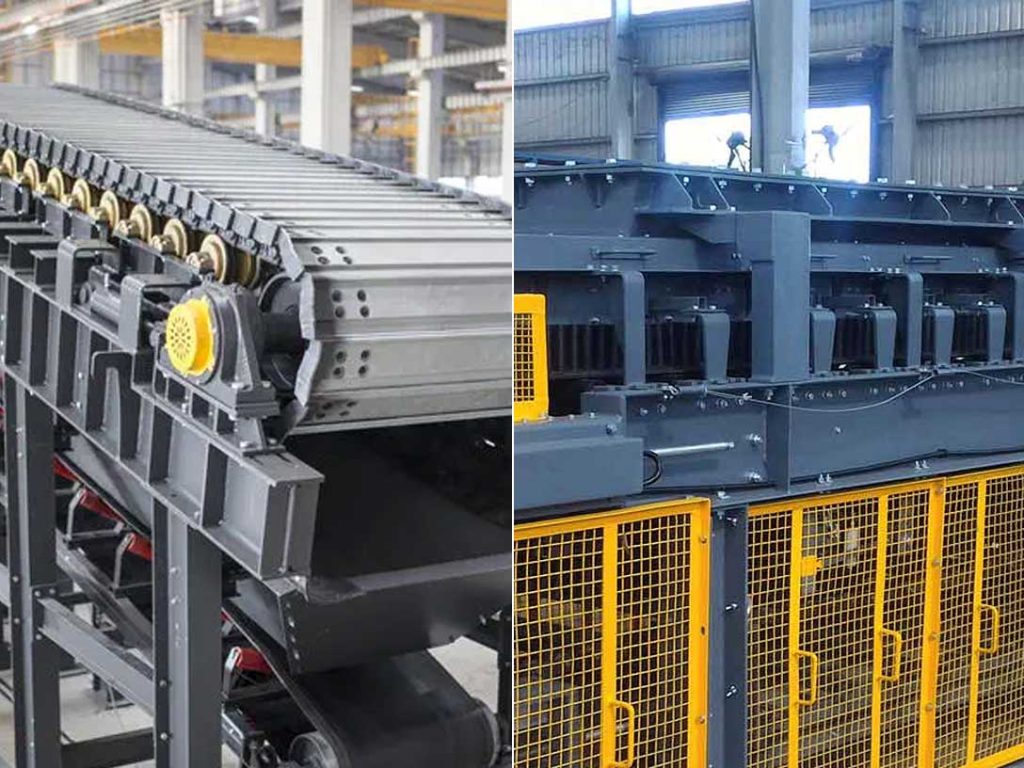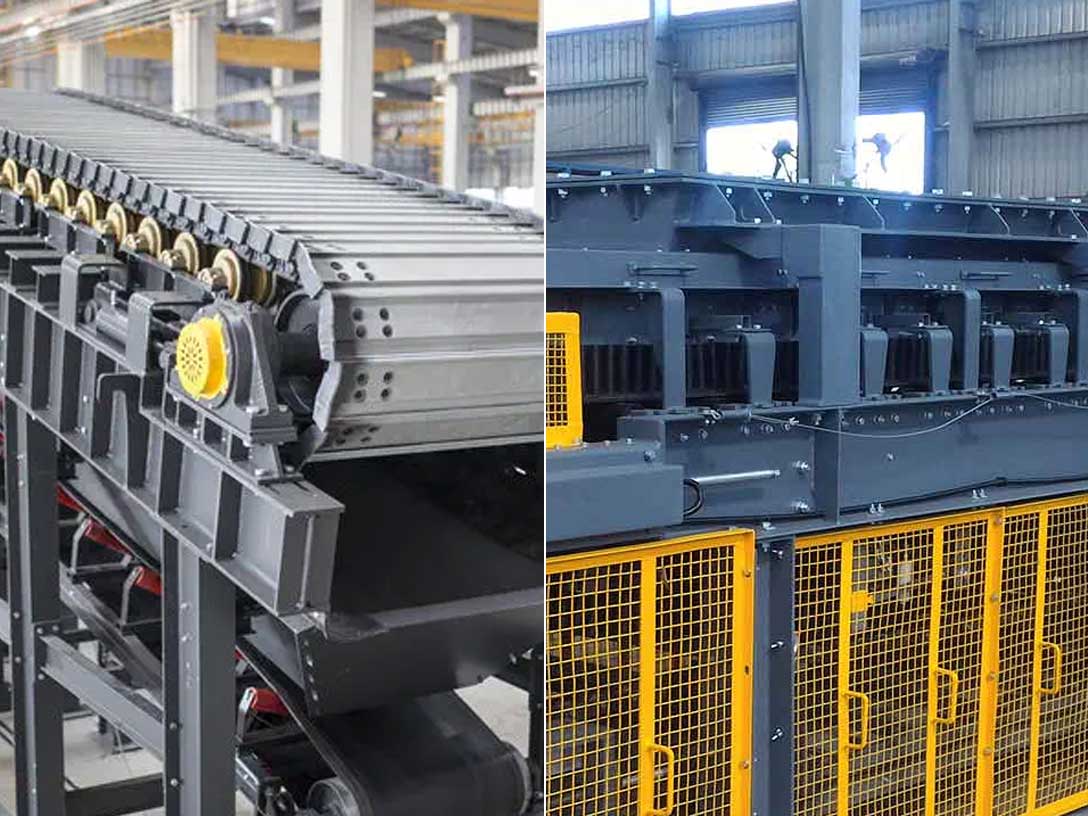An apron conveyor and a belt conveyor are two types of material handling equipment used in various industries to transport materials from one location to another. These conveyors differ in their design, operation, and application. In this article, we will explore the differences between apron and belt conveyors in detail.
Design and Operation

An apron conveyor, also known as a plate conveyor, is a type of conveyor that uses metal plates or slats to carry materials. The plates or slats are connected to a chain that moves them along a designated path. Apron conveyors are typically used for moving heavy, abrasive, or hot materials such as cement, coal, or steel. They are designed to withstand harsh environments and heavy loads.
Apron conveyors are available in different configurations, including a single-strand or double-strand chain arrangement. The choice of chain arrangement depends on the application, load capacity, and environmental conditions. Single-strand apron conveyors are suitable for transporting lighter materials, whereas double-strand apron conveyors are used for heavier loads.
The metal plates or slats used in apron conveyors are made from materials that are resistant to wear and tear, such as steel, cast iron, or manganese. The chains used in apron conveyors are also made from high-strength materials, such as alloy steel, to withstand heavy loads.
A belt conveyor uses a continuous loop of material, such as rubber, nylon, or steel, to move items along a flat or inclined surface. Belt conveyors are used for a wide variety of applications, such as in manufacturing, warehousing, and transportation industries. They are suitable for moving lightweight to heavy materials, depending on the strength of the belt and the design of the conveyor.
Belt conveyors can be designed with different belt materials, such as rubber, PVC, or nylon, depending on the application. They can also be designed with different belt widths and lengths to accommodate different loads and distances. The belt is driven by a motor, which moves the belt and the materials along the conveyor.
Material Handling Capacity
Apron conveyors are designed to handle heavy loads and abrasive materials. They are commonly used in industries such as cement, steel, mining, and power generation. Apron conveyors can transport materials at high temperatures and in harsh environments, making them ideal for handling hot materials such as clinker, slag, or ash.
The load capacity of an apron conveyor depends on the size and strength of the chain and the material used for the plates or slats. Single-strand apron conveyors can typically handle loads up to 1,000 tons per hour, while double-strand apron conveyors can handle loads up to 2,000 tons per hour.
Belt conveyors can handle a wide range of materials and loads, from lightweight to heavy. They are commonly used in industries such as food processing, packaging, and logistics. Belt conveyors can transport materials over long distances and can be used for inclines or declines. They can also be designed with multiple belts to handle different types of materials.
The load capacity of a belt conveyor depends on the strength of the belt and the design of the conveyor. Heavy-duty belts can handle loads up to several thousand tons per hour, while lighter belts are suitable for handling smaller loads.
Application
Apron conveyors are commonly used in industries where heavy loads and abrasive materials need to be transported. These industries include cement, steel, mining, and power generation. Apron conveyors are also used in applications where the materials need to be transported at high temperatures, such as in the processing of hot clinker or ash.
Belt conveyors are suitable for transporting a variety of materials, such as grains, ores, chemicals, and finished products. They can be used for horizontal, inclined, or declined transport, depending on the application. They can be designed to handle different types of packages, such as boxes, bags, and containers, and can be used for sorting, merging, and diverting packages. They can be designed with multiple belts, curves, and transfer points to handle complex manufacturing processes.
Apron conveyors are not as versatile as belt conveyors and are primarily used for heavy-duty applications. They are designed to handle specific types of materials, such as cement, coal, or steel, and are less commonly used for general material handling.
Maintenance and Operating Costs
Apron conveyors require regular maintenance to ensure their reliability and longevity. The chains, plates, and bearings need to be inspected and lubricated regularly to prevent wear and tear. The plates or slats may need to be replaced periodically due to wear, and the chains may need to be tensioned to ensure proper operation.
Belt conveyors are generally easier to maintain than apron conveyors, as they have fewer moving parts. The belts may need to be replaced periodically due to wear, but this is a simple and straightforward process. Belt conveyors require less lubrication and tensioning than apron conveyors, which can result in lower maintenance costs.
Operating costs for apron conveyors are generally higher than for belt conveyors due to their heavier construction and higher maintenance requirements. The chains, plates, and bearings used in apron conveyors are more expensive than the belts and pulleys used in belt conveyors. The higher operating costs for apron conveyors may be offset by their higher load capacity and ability to handle heavy, abrasive, or hot materials.
Conclusion
In conclusion, apron conveyors and belt conveyors are both types of material handling equipment used to transport materials from one location to another. They differ in their design, operation, application, material handling capacity, and maintenance requirements.
Apron conveyors are typically used for heavy-duty applications, such as in cement, steel, mining, and power generation industries. They are designed to handle heavy, abrasive, or hot materials and are less commonly used for general material handling.
Belt conveyors, on the other hand, are versatile and can be used in a wide range of industries, such as food processing, packaging, logistics, and manufacturing. They can handle a wide range of materials and loads, from lightweight to heavy, and can be used for horizontal, inclined, or declined transport.
Overall, the choice between an apron conveyor and a belt conveyor depends on the specific application and the materials being transported. It is important to consider the load capacity, operating costs, and maintenance requirements when selecting a conveyor for a particular application.
